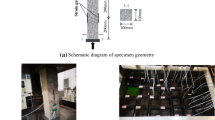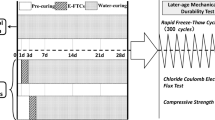Abstract
Freeze-thaw durabilities of three types of concretes-normal portland cement concrete (OPC), high strength concrete (HSC) and steel fiber reinforced high strength concrete (SFRHSC) were systemically investigated under the attacks of chemical solution, and combination of external flexural stress and chemical solution. Four kinds of bitterns from salt lakes in Sinkiang, Qinghai, Inner Mongolia and Tibet provinces of China were used as chemical attack solutions. The relative dynamic modulus (RDM) was used as an index for evaluating the damage degree during the course of chemical attack and stress corrosion. The experimental results show that the freeze-thaw durability of concrete is visibly reduced in the present of the flexural stress, i e, stress accelerates the damage process. In order to quantify the stress accelerated effect, a stress accelerating coefficient was proposed. The stress accelerating coefficient is closely related with the types of bitterns and the numbers of freeze-thaw cycles is. The more numbers of freeze-thaw cycles is, the greater the stress accelerating coefficient for various concretes will be. In addition, there also exists a critical ratio of external stress to the maximum flexural stress. If the stress ratio exceeds the critical one, the freeze-thaw durability of various concretes will be greatly decreased compared to the responding concretes without applied stress. The critical stress ratio of OPC, HSC and SFRHSC is 0.30, 0.40 and 0.40, respectively, indicating that HSC and SFRHSC have advantages over OPC and are suitable to use in the bittern erosion regions.
Similar content being viewed by others
References
Aitcin P C, Pigeon M, Pleau R, et al. Freezing and Thawing Durability of High Performance Concrete[C]. In: Proceedings of the International Symposium on High-performance Concrete and Reactive Powder Concretes. Sherbrooke, Quebec: Concrete Canada, 1998(4):383–391
Mehta P K. Studies on Chemical Resistance of Low Water-cement Ratio Concretes[J]. Cem. Concr. Res., 15(6):969–978
Janssen D J, Snyder M B. Mass Loss Experience with ASTM C666: with and without Deicing Salt[C]. In: Proc. the Inter. Workshop in the resistance of Con. to Scaling due to Freezing in the Presence of Deicing Salt, Quebec, Canada, 1997: 247–258
Mu Ru, Miao Changwen, Liu Jiaping. Properties of Concrete Subjected to Freezing and Thawing under Sulphate Attack[J]. Indian Concrete Journal, 2001, 75(7):451–454
Mu Ru, Miao Changwen, Breugel K V, et al. Properties of Air-entrained Concrete Subjected to Freeze-thaw Cycles and Salt Attack Simultaneously[C]. In: Advanced in Concrete and Structures, Proceedings of the International Conference ICACS 2003, XuZhou, 982–988
Mu Ru, Miao Changwen, Liu Jiaping, et al. Effect of NaCl and Na2SO4 Solution on the Frost Resistance of Concrete and Its Mechanism[J]. J. Chin. Ceram. Soc., 2001, 29(6): 523–529(in Chinese)
Yu Hongfa, Sun Wei, Wu Weifeng, et al. Research on Bittern-freezing-thawing Durability and Destructive Mechanism of Ordinarily Concrete Exposed to Salt Lakes[J]. J. Chin. Ceram. Soc., 2003, 31(8):763–769 (in Chinese)
Yu Hongfa, Sun Wei, Yan Lianghui, et al. Freezing-thawing Durability of High Strength and High Performance Concrete Exposed to Salt Lakes[J]. J. Chin. Ceram. Soc., 2004, 32(7): 842–848 (in Chinese)
Yu Hongfa, Sun Wei, Yan Lianghui, et al. Research on Freezing-thawing Durability of Air-entrained Concrete Exposed to Salt Lakes[J]. J. Wuhan Uni. Tech., 2004, 26(3): 15–18 (in Chinese)
Zhou Yixia, Cohen M D, Dolch L W. Effect of External Loads on the Frost-resistant Properties of Mortar with and without Silica Fume[J]. ACI Mater. J., 1994, 91(6):595–601
Sun Wei, Zhang Y M, Yan H D, et al. Damage and Damage Resistance of High Strength under the Action of Load and Freezing Thawing Cycles[J]. Cem. Concr. Res., 1999, 29(6): 1519–1523
Zivica V, Szabo V. The Behaviour of Cement Composite under Compression Load at Sulphate Attack[J]. Cem. Concr. Res., 1994, 24(8):1475–1484
Schneider U, Nagele E. Stress Corrosion of Cement Mortars in Ammonium Sulfate Solution[J]. Cem. Concr. Res., 1993, 23(1):13–19
Schneider U, Chen S W. Modeling and Empirical Formulas for Chemical Corrosion and Stress Corrosion of Cementitious Materials[J]. Mater. and Struct., 1998, 31(10):662–668
Schneider U, Chen S W. The Chemomechanical Effect and the Mechanochemical Effect on High-performance Concrete Subjected to Stress Corrosion[J]. Cem. Concr. Res., 1998, 28(4):509–522
Schneider U, Chen S W. Behaviour of High-performance Concrete under Ammonium Nitrate Solution and Sustained Load[J]. ACI Mater. J., 1999, 96(1):47–51
Yu Hongfa, Sun Wei, Liu Lianxin, et al. The Stress Corrosion of Concrete Exposed to Salt Lakes[J]. Journal of Harbin Institute of Technology, 2007, 39(12):1965–1968(in Chinese)
Sun Wei, Mu R, Luo X, et al. Effect of Chloride Salt, Freeze-thaw Cycling and Externally Applied Load on the Performance of the Concrete[J]. Cem. Concr. Res., 2002, 32(12):1859–1864
Sun Wei, Yu Hongfa, Wang Qing, et al. Effect of Flexural Stress on Bittern Freezing-thawing Durability of Concrete Eexposed to Salt Lakes[J]. J. Wuhan Uni. Tech., 2005, 27(7): 46–49 (in Chinese)
Yu Hongfa, Mu Ru, Sun Wei, et al. Effects of Flexural Loads, Chemical Attack, Carbonation and Their Combination of Freezing-thawing Durability of Concretes[J]. J. Chin. Ceram. Soc., 2005, 33(4):492–499 (in Chinese)
Ababneh A N. The Coupled Effect of Moisture Diffusion, Chloride Penetration and Freezing-thawing on Concrete Durability[D]. Denver: University of Colorado, 2002
Mu Ru, Yan An, Sun Wei. Durability of HSC and SFRHSC on the Simultaneous Actions of Freeze-thaw Cycles and Loads[J]. Industrial Construction, 1998, 28(8):11–14 (in Chinese)
Yu Hongfa. Study on High Performance Concrete in Salt Lake: Durability, Mechanism and Service Life Prediction[D]. Nanjing: Southeast University, 2004(in Chinese)
Author information
Authors and Affiliations
Corresponding author
Additional information
Funded by the National Natural Science Foundation of China(No. 59938170 and 50178044), the Natural Science Foundation of Jiangsu Province of China (No. BK2005216)
Rights and permissions
About this article
Cite this article
Yu, H., Sun, W., Zhang, Y. et al. Durability of concrete subjected to the combined actions of flexural stress, freeze-thaw cycles and bittern solutions. J. Wuhan Univ. Technol.-Mat. Sci. Edit. 23, 893–900 (2008). https://doi.org/10.1007/s11595-007-6893-1
Received:
Accepted:
Published:
Issue Date:
DOI: https://doi.org/10.1007/s11595-007-6893-1




